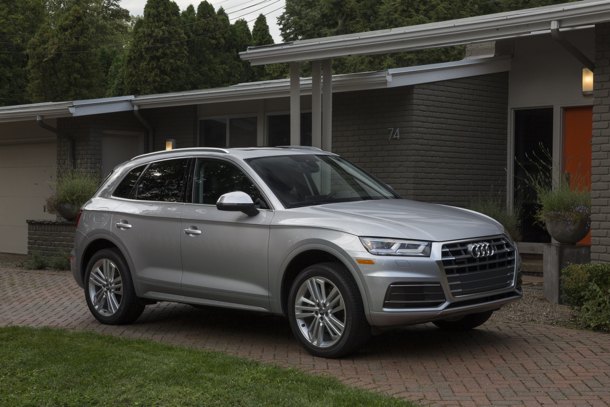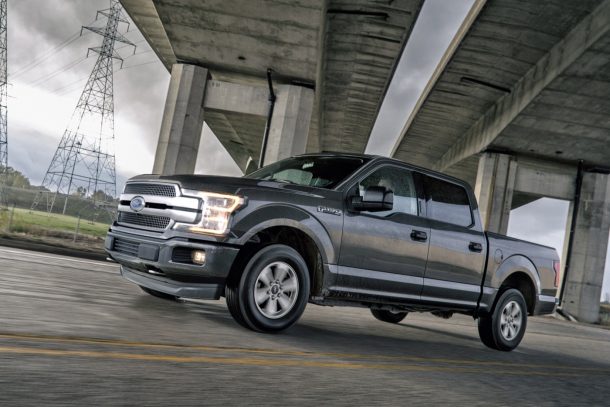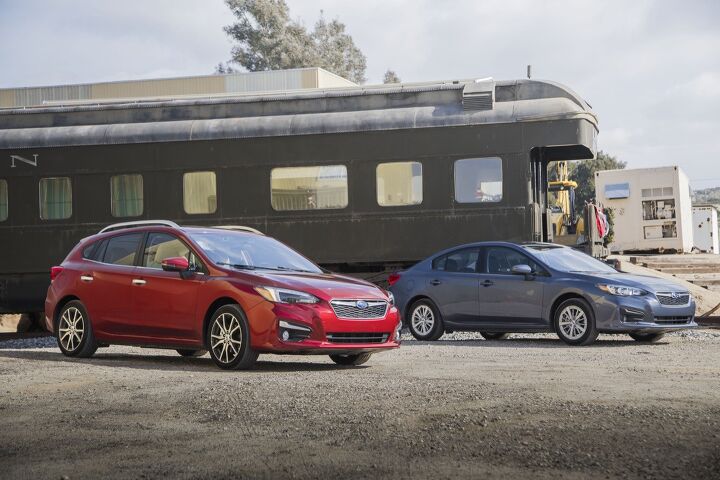#AutoSales
So Far, 2018 Auto Sales Are Better Than Expected; Thank Dangerously Heavy Incentives
With the automotive market continuing to cool off, the industry went into 2018 with a less than optimistic view. Volume for the year is anticipated to continue its downward trend but, incredibly, January appears to be on par with the same period last year — if not slightly better.
Did the analysts get it wrong? Probably not. Incentive spending was up across the board and that’ll likely be the case throughout the rest of the year. The real trick will be for automakers to keep their lineups appealing without going wild with discounts. That’s because the annual forecast still calls for lower volume than in 2017.
Ghosn Says Nissan's Alliance Makes It the Biggest Dog in the Auto Yard
Despite Volkswagen delivering an impressive 10.74 million vehicles in 2017, Nissan-Renault Alliance head Carlos Ghosn says his automotive group was actually the top sales dog. VW managed a 4.3-percent increase over last year’s volume and set a new record for itself, but Ghosn argues that doesn’t matter if it’s counting heavy truck sales in its total sum.
“The [Renault-Nissan] alliance, with more than 10.6 million light private and commercial vehicles sold in 2017, is the premier global automobile group,” the CEO told a parliamentary committee hearing in Paris.
Everyone Leases Electric Vehicles Because the Next Crop Will Always Be Better
The automotive industry frames electric vehicles as the future of motoring, but despite a large number of plug-in options already available, the entire idea of owning an electric car is still rather futuristic. Leasing one, however, is far more contemporary.
Growing in popularity, automotive leasing hit a record high in 2016, accounting for 31 percent of all new vehicle sales in the United States. But that’s nothing when you isolate the number of electric cars. U.S. drivers now lease nearly 80 percent of battery-electric vehicles and 55 percent of all plug-in hybrids. Accounting for this trend is a consumer perception that EVs will only get better over time — which isn’t all that different from saying the current fleet isn’t all that impressive.
U.S. Auto Sales Brand-by-Brand Results - November 2017 YTD
With a single month remaining in 2017, automakers are ramping up sales efforts in the hopes of finishing the year on a high note. At this time of year, most stores deploy all the tools in their arsenal, from magical incentives to generous trade-in values, in a bid to compete with consumer dollars generally spent elsewhere during December.
The preceding month was solid but not stunning, leading some to openly wonder if this’ll be the first year since the Bankruptcy Days that total industry sales will be a few units less than the previous 12 months.
Auto Loan Delinquencies Continued to Climb in the Last Quarter
The 60-day auto delinquency rate continued to climb through the third quarter of 2017. Driven primarily by “relaxed” underwriting standards from years past and increasing subprime originations, TransUnion’s senior vice president and automotive business head, Brian Landau, said two-month payment lapses rose 7 basis points to 1.4 percent.
At the same time, the average balance of outstanding auto loans increased by around 5.9 percent, resulting in the lowest year-over-year growth rate since the third quarter of 2012. The group’s Industry Insights Report cited this quarter’s serious auto loan delinquency rate as the highest observed since Q3 2009 — you know, when nobody had any money to pay their bills.
America's Love for Luxury SUVs Is Screwing With Off-lease Sedan Sales
North America’s love affair with SUVs and crossovers arose so suddenly and with such passion that manufacturers were left scrambling to meet demand. Luxury brands certainly aren’t exempt from this but, unlike mainstream marquis, the sudden shift in product demand has thrown those marques a bit of a curveball.
Since prestige brands tend to possess substantially higher leasing rates than their more-affordable contemporaries, luxury automakers are getting stuck with off-lease sedans that nobody seems to want. While that’s terrible news for corporate accountants, it’s good news for anyone looking for a good deal on a used Lexus ES or Audi A4.
U.S. Auto Sales Brand-by-Brand Results: October 2017 YTD
It was only a mere blip, the year-over-year increase reported by the U.S. auto industry in September 2017. After eight consecutive months of decline, auto sales grew in September. But October’s results once again manifested a gradual and marginal decline.
U.S. auto sales slid roughly 1 percent in October 2017 thanks in large part to sharp decreases at Fiat Chrysler Automobiles’ Dodge brand and a 15-percent Hyundai drop. Chrysler, Fiat, Jaguar, and Maserati were the only other brands to report double-digit percentage losses.
Brexit Seems to Have Really Screwed Up Britain's Car Market
While some of Europe saw modest auto sale gains through the first nine months of 2017, the region has mirrored North America’s decline in deliveries since the end of the summer. The United States saw eight consecutive months of declining sales this year, with a positive bump in September and better than expected volume in Canada.
Europe, meanwhile, saw the inverse. Passenger car registrations fell 2 percent year-over-year to roughly 1.43 million deliveries in September, despite August seeing a 5.6-percent improvement. Overall, 2017 has the makings of a unsatisfactory sales year for both regions. But Europe seemed to be doing alright before the U.K. suddenly stopped buying cars.
British registrations took a massive nosedive after Brexit. By September, it represented a monthly decline of 9.3 percent, compared to Germany’s 3.3 percent slide. Even though the rest of the continent saw a gain in sales, having Europe’s two largest markets lagging guaranteed the net loss.
If U.S. Auto Sales Were Growing Like Canadian Auto Sales, Americans Would Buy 18.5 Million Vehicles In 2017
In concert with the American auto industry, Canada’s auto industry reported an all-time record year of sales in 2016.
The difference? In Canada, 2016 represented the fourth consecutive year of record sales. Another difference? Canadian auto sales just kept on growing throughout 2017. Most recently, that streak of increases included an 8-percent year-over-year uptick in September 2017. Sales last month were 16-percent stronger than they typically are in September.
Month after month after month, Canada’s auto industry just keeps on smashing records. It’s as if the U.S. auto industry posted its banner year of 17.5 million sales in 2016 and then bettered that with 18.5 million sales in 2017.
Camry Crusher: Honda Civic Expands Lead as America's Best-selling Car
In many ways, September 2017’s auto sales bucked the trend. After the industry combined for decreased volume, year-over-year, in each of 2017’s first eight months, auto sales in September rose 6 percent. Meanwhile, the shrinking car sector that tumbled 12 percent through the first two-thirds of 2017 was down only 3 percent in September.
There were two big reason the passenger car decline wasn’t worse: America’s two best-selling cars.
Excluding the Honda Civic and Toyota Camry, U.S. car sales fell 6 percent. But as the clear-out of remaining 2017 Honda Accords got underway and produced 10-percent growth, the launch of the 2018 Toyota Camry generated a 13-percent uptick. Meanwhile, the Honda Civic’s 26-percent surge allowed the compact Honda to expand its lead over the midsize Camry in the race to end 2017 as America’s best-selling car.
U.S. Auto Sales Brand-by-Brand Results: September 2017 YTD
U.S. auto sales exceeded analyst expectations with a big 6 percent year-over-year increase to 1.5 million units in September 2017, the first monthly improvement in 2017 so far.
After auto sales fell 3 percent during the first two-thirds of 2017, big September increases from Toyota Motor Corp., General Motors, Ford Motor Company, American Honda, Nissan’s trio of brands, and numerous smaller outfits brought the sales pace achieved through the first three-quarters of 2017 within sight of 2016’s record rate. By the end of September, U.S. auto sales are down by less than 2 percent compared with last year.
Pickup trucks played a major role in September’s improvements, growing at twice the rate of the industry at large. The Honda Civic expanded its lead as America’s best-selling car on a quest to end the Toyota Camry’s 15-year run. Minivan sales plunged to barely more than 33,000 units. The Toyota RAV4 topped 42,000 sales for a second consecutive month, leading a booming SUV/crossover class.
September 2017 Was a Terrific Month For Pickup Truck Sales in America
September 2017 sales of pickup trucks rose to the highest level so far this year in the United States, jumping 12 percent to 257,864 units.
Prior to this point, truck sales had grown by less than 4 percent, year-over-year, averaging slightly more than 225,000 monthly units.
September’s big gain was fuelled almost entirely by improvements among the full-size pickup trucks that own 84 percent of America’s pickup truck market. And America’s full-size pickup truck gains were powered in large part by America’s best-selling line of vehicles: the Ford F-Series.
For the First Time in 2017, September Auto Sales May Have Increased, Slightly, Perhaps
Both Edmunds and Kelley Blue Book are forecasting marginal year-over-year sales increases for the U.S. auto industry in September 2017.
If the analysts prove correct, it will be the industry’s first month of growth since December of last year. What’ll it take to push the industry beyond the 1.43 million new vehicles sold in September 2016?
The big gains from General Motors and Toyota will have to be big enough to overcome big losses from Fiat Chrysler Automobiles and Hyundai-Kia.
These 16 Cars Are Bucking America's Anti-Car Trend in 2017
Through the first eight months of 2017, consumers across America have acquired 12 percent fewer new passenger cars than during the first eight months of 2016.
That’s a drop of 565,000 sales, a rate of decline that stands in stark contrast to the U.S. auto industry’s 4-percent year-over-year light truck improvement. Cars now account for just 37 percent of all auto sales, down from more than 50 percent as recently as 2012. But it’s not all doom and gloom. Some auto brands are selling more cars this year than last, and a wide variety of cars are accelerating their sales pace. Subaru, for example, has already sold 17,981 more Imprezas in 2017 than in the same period of 2016.
So we’ve compiled a list of every passenger car that’s making meaningful headway in America’s anti-car market — the cars that are selling more and more often even as many of their competitors suffer under the weight of a pro-F150, pro-RAV4, pro-Escalade ESV wave.
The list is not very long.
Canadian Auto Sales Would Have to Plummet in Final Third of 2017 for This to Not Be the Industry's Best Year Ever
Canadian auto sales climbed to an all-time record high in 2013, jumping past the 1.7-million mark for the first time since 2002. The industry bettered that total in 2014, topped 2014’s total in 2015, and set a new record in 2016.
While U.S. auto sales continue to fall, sliding 2 percent in August and 3 percent through the first two-thirds of 2017, Canadian auto sales in August 2017 improved for a fourth consecutive month and the seventh month so far this year. Moreover, the improvements have been anything but modest. An 11-percent uptick in May was followed up by a 6-percent June increase, a 5-percent July increase, and a 7-percent August rise.
In fact, so strong are Canadian auto sales through the first two-thirds of 2017 that disaster would need to strike in the final four months of the year in order for 2017 not to be the best year ever for the Canadian auto industry.
Disaster appears unlikely.





























Recent Comments